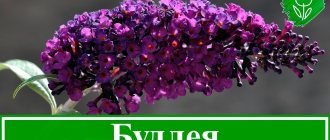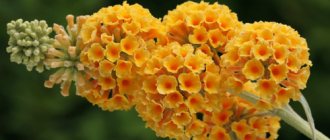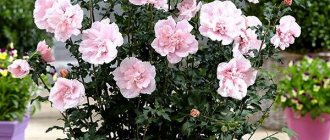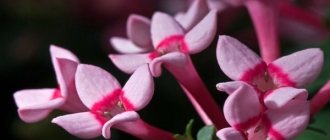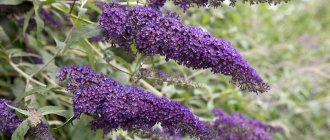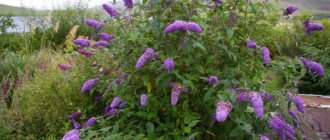The buddleja bush (Buddleja) is also called buddleya, it is directly related to the burrow family. Under natural conditions, it can be found in temperate and warm areas of Asia, South Africa and America. This shrub was named in honor of the Englishman A. Buddle, who was a botanist of the late 17th and early 18th centuries. In its homeland, this plant was called orange-eyed. Budleya is also called “butterfly tree” or “butterfly magnet”. And all because the flowers of such a shrub have a strong honey smell, thanks to which large, very spectacular butterflies flock to pollinate them. During flowering, the branches of this plant are very similar to lilacs, which is why it is also called “autumn lilac.”
Features of Buddleia
There are a large number of buddleia species in nature, approximately 100 to be exact. This genus is represented by deciduous or semi-evergreen shrubs and herbaceous plants. They bloom late and for quite a long time. The peculiarity of buddleia is that during the flowering period, flowers, buds and fruits are simultaneously present on its branches.
The height of the bush can vary from 150 to 300 centimeters. In most species, the leaf plates arranged in pairs have a lanceolate shape, which can reach 1–30 centimeters in length. In Asian species, panicle-shaped inflorescences can range from 10 to 50 centimeters in length. And American species have spherical inflorescences. The small tubular flowers are very fragrant and honey-bearing; they are divided into 4 lobes, like lilac flowers. They can be painted in a variety of colors: red, yellow, lilac, white, pink, orange, crimson. At the same time, the color intensity of the flowers may vary. The fruits are oblong-shaped capsules containing seeds inside. Cultivated species and varieties are frost-resistant, but if the plants are not covered, they may freeze out in a winter with little snow. However, only that part of the plant that is above the ground will die, and in spring young shoots will appear from the ground in large numbers, and in the same year they may begin to bloom. There are species that have high frost resistance; they are not afraid of frosts down to minus 20 degrees.
Budleya bloomed all summer
Kinds
Although there are not many varieties of buddleia in nature, breeders have developed a large number of different varieties. First of all, shrub hybrids differ in the shade of their flowers.
David
A mixture of inflorescence colors can be found if you pay attention to the Buddleia David variety. This variety is considered the most common and popular among summer residents
The variety is characterized by spreading bushes. The bushes are easy to form, and the inflorescences emit a light honey aroma during flowering.
Royal Red
The Royal Red variety is characterized by rich burgundy-lilac inflorescences collected in long panicles. The length of these panicles is from 30 to 45 cm. The adult bush is of a spreading type. The height is usually from 2 to 3.5 m. The width of the bush is from 2 to 4 m.
Alba
The shrub of the Alba variety is medium in size, grows up to 2 m in height, not spreading, heavily leafy. Petals are white. The flowering period occurs in July and continues until October.
Black Knight
The Black Knight variety is characterized by rich purple inflorescences, with a yellow border in the middle of the flower. Medium-sized shrub.
Orchid Beauty
A low-growing variety, grows up to 1.5 m in height, not spreading. The color of the petals of the flowers is lilac-pink. The flowering period is late, beginning in August and ending at the end of September.
Flower Power
The bushes grow up to 2 meters. The inflorescences are long, about 30 cm. The shade of the petals is purple and orange. The flowering period is short, only one and a half months.
Border Beauty
Sprawling bush with drooping branches. The plant grows up to 1.5 m in height and about 2 m in width. The flowers are lavender in color; unlike other varieties, the inflorescence has a strong honey aroma.
Empire Blue
This variety has an unusual shade of inflorescences, the petals are blue-violet. The adult shrub is of a spreading type, the branches are of the drooping type. The bush blooms in July. Flowering continues until mid-September.
Mix
The Buddleia Mix variety is distinguished by the fact that the inflorescences in the bush come in three shades - red, white and lavender. The bush is spreading, tall, growing up to 2.5 m in height.
Pink do light
The inflorescences are pale pink, the panicle grows up to 50 cm in length. The bush is medium-sized, up to 3 m high. The flowers emit a strong honey aroma, thereby attracting insects to the garden.
Ile de France
The height of an adult shrub of this variety is 2.5 m. The inflorescences are about 40 cm long. The petals are violet-lilac. Flowering occurs from July to September.
The inflorescences of this variety are large and rich pink.
Alternate leaf
This variety belongs to almost wild shrubs that grow in their natural environment. The height of the bush is about 4 m. The flowers are small, lavender in color. The flowering period is very short and does not exceed 25 days.
Snezhnaya
The foliage of this variety is covered with fine white fibers, so the leaves appear to be very light. Lilac inflorescences.
Japanese
A medium-sized shrub 2-3 m high. The inflorescences are collected in panicles of small lavender flowers, emitting a strong honey aroma.
Globular
Unlike most varieties, the inflorescences of this variety are not collected in panicles, but are presented in a spherical shape. The shade of the petals is rich yellow.
The inflorescences are of multi-colored shades, the bush is medium-sized, growing up to 2.5 m in height.
Changeable
The shrub grows up to 3 m in height. In some cases, the height of the plant can reach 5 m. Due to the abundant flowering, the branches droop. The inflorescences are purple in color with a rich honey aroma that attracts insects. The flowering period occurs at the end of summer.
Indian
Buddleia indica belongs to bonsai and is grown at home. This variety is light-loving, and if there is not enough sunlight in the house, for example, in winter and autumn, you need to turn on additional lighting.
Growing buddleia from seeds
In mid-latitudes, buddleia seeds on a bush most often do not ripen, but you can resort to such tricks as stratification or sowing on a snow layer. Experts advise purchasing the seeds of this plant in a specialized store, and it is best to choose imported producers. Buddleia seeds are very small; to make sowing easier, it is recommended to combine them with sand. Fill wide bowls with neutral soil. There should be holes at the bottom of the container for drainage, and do not forget to make a good drainage layer. Sow the seeds onto the surface of the substrate and press them lightly (do not bury them). Water the crops using a sprayer and cover the container with glass or film. The bowl should be placed in a warm place with an air temperature of 22 to 25 degrees; it should be well lit and protected from direct rays of the sun. Sowing should be done at the beginning of spring. The first seedlings will appear after 7–14 days. The plant needs to be systematically ventilated and watered. In order to avoid the development of “black leg”, it is necessary to use a pinkish-colored potassium manganese solution for watering from time to time.
Buddleia seedlings
After the young plants grow up, the shelter can be removed. After 2–3 pairs of true leaves appear, the buddleia should be transplanted into individual containers, preferably peat pots. After this, the seedlings need to be hardened in the fresh air; to do this, open the window for a short time, but there should be no draft.
Buddleya David
Varieties:
Buddleja Davidii or changeable - Buddleja Davidii
A beautifully flowering multi-stemmed shrub up to 5 m high, it was named after the priest Armand David, who first wrote down a description of the plants. The plant develops quickly, has opposite, simple, oblong-lanceolate leaves up to 20 cm long. The flowers are small, fragrant, in shades of lilac, purple, white, yellow or pink, collected in large apical racemes.
Most modern varieties are bred on the basis of this particular plant.
Buddleja Royal Red - Buddleja davidii "Royal Red"
Abundantly branching shrub up to 1.5 m high with narrowly lanceolate green or bluish-green leaves. During the flowering period, the plant forms large fragrant racemes up to 25 cm long with many crimson or burgundy flowers.
Buddleja Black Knight - Buddleja davidii "Black Knight"
Large flowering deciduous shrubs with a rounded crown up to 3.5 m high. The leaves are green, lanceolate, located opposite. The plant has large apical racemes up to 20 cm long, consisting of a large number of spectacular, fragrant, dark purple, almost black flowers.
Buddleja Flower Power - Buddleja davidii "Flower Power"
A spectacular flowering plant, the main distinguishing feature of which is large inflorescences - brushes, painted in 2 shades. Unopened buds of this variety have a purple hue, while opening flowers have a pink tint, and once open flowers turn salmon or orange.
Buddleja "Nanho Blue" - Buddleja davidii "Nanho Blue"
Compact deciduous shrub up to 1.5 m high with gray-green oblong leaves and large clusters up to 25 cm long, consisting of soft lilac or blue flowers. The flowering period is very long, begins in June and continues until mid-autumn.
Buddleja "Adonis Blue" - Buddleja davidii "Adonis Blue"
Shrubs with bluish-green or gray-green foliage, during the flowering period they form long, narrow racemes with small lavender flowers.
Buddleja "Empire Blue" - Buddleja davidii "Empire blue"
Relatively compact shrubs up to 2 m high with green narrow-lanceolate opposite leaves and long (up to 25 cm) clusters of dark blue fragrant flowers.
Buddleja "Harlequin" - Buddleja davidii "Harlequin"
This variety can be safely classified as both a flowering plant and an ornamental foliage plant, because in addition to large flower clusters, it has a rich purple hue and attractive foliage. The green leaf blades along the edges are painted white or cream.
Buddleia "Ile de France" - Buddleia davidii "Ile de France"
A large deciduous shrub up to 2.5 m high with erect branched shoots, green narrow leaves and long conical racemes of fragrant pink or purple flowers.
Buddleja "Gulliver" - Buddleja davidii "Gulliver"
"Gulliver" is a compact deciduous shrub up to 1.75 m high with spear-shaped, gray-green leaves. A distinctive feature of the variety is its very large inflorescences - apical panicles up to 30 cm long with lilac fragrant flowers.
Buddleia Weyer - Buddleia x weyeriana
Beautiful flowering shrubs bred during the First World War by the military man, Major William van de Weyerer. A distinctive feature of the plants is the golden-orange or yellow hue of the flowers. Weyer's buddleia often forms not the usual brushes, but spherical inflorescences or brushes, which contain several such rounded formations at once.
Buddleia "Sungold" - Buddleia weyeriana "Sungold"
A charming flowering shrub with grayish-green lanceolate leaves and golden clusters of small fragrant flowers.
Buddleja alternifolia
Deciduous multi-stemmed shrub with thin, often drooping shoots. The leaves are small, lanceolate, gray-green. During the flowering period, the plant is abundantly covered with long (up to 50 cm), hanging inflorescences of lilac flowers and its appearance resembles a weeping willow.
You might also be interested in:
Hydrangea
Rhododendron
Juniper
Hellebore
Planting Buddleia
What time to plant
Buddleia should be planted only after the threat of frost has passed. The area suitable for planting must be well lit and at the same time protected from strong gusts of wind, as well as from drafts. The soil should be neutral, well-drained, moist, and rich in nutrients.
How to plant Buddleia
When planting, you should take into account that buddleia bushes grow greatly, so you must leave a decent distance between them, otherwise they will be very crowded. The planting hole should have a size of 40x40 centimeters. The depth of the hole should be equal to the size of the root system plus 20 centimeters. A drainage layer should be made at the bottom of the hole, and fertilizer should also be added. The height of the drainage layer should be from 10 to 15 centimeters. To create it, you should use material of a large fraction. A handful of garden soil is poured on top of this layer, which should be mixed with the same amount of compost and mineral fertilizer. Then you need to place a seedling on this mound and straighten its roots. Pour the required amount of soil into the hole, after which it needs to be compacted. Then the plant is watered, and the surface of the soil is covered with a layer of mulch (compost). Make sure that when planting, the root collar is flush with the soil surface.
Planting and caring for Buddleia Davida Border Beauty
If you decide to grow Buddleia David of the Border Beauty variety in your garden, you should take care of choosing a suitable place for planting. By and large, recommendations for planting this variety do not differ from those inherent in other varieties of buddleia.
The plant prefers unshaded, well-lit places where there are no drafts. The Border Beauty variety is quite picky about soil composition and can grow with equal success on chalk, loamy and clay soils. In terms of acidity level, soil with a neutral pH value (from 5 to 7 pH), slightly acidic or slightly alkaline is suitable for it. Regardless of the type, the soil should drain well and be moistened regularly.
Important! Poor drainage and too dry or, conversely, wet soil can provoke the appearance of various diseases. Border Beauty seedlings are placed in open ground in late April - early May, after the soil has thoroughly warmed up.
Before this, Buddleia David seedlings are watered and pricked abundantly, and the cuttings are soaked in root solution for 10 - 18 hours
Border Beauty seedlings are placed in open ground in late April - early May, after the soil has thoroughly warmed up. Before this, Buddleia David seedlings are watered and pricked abundantly, and the cuttings are soaked in the root solution for 10 to 18 hours.
Plants are planted as follows:
- Prepare a planting hole measuring 40x40 cm at a distance of 2 - 2.5 m from other plantings.
- Drainage is poured into the bottom of the hole so that it forms a layer of 10 - 15 cm.
- A layer of soil fertilized with an ash solution or compost is poured over the drainage.
- Planting material for Buddleia David is placed in the ground and sprinkled with earth, then the plant is watered abundantly.
- After planting, the Border Beauty buddleia is mulched with peat or straw.
Features of care
Watering this shrub should be done only during hot, dry periods. For 1 bush, take 10 liters of well-settled lukewarm water. Water is poured into a groove that should be made around the plant. Budleya is a fast-growing plant; its stems can grow up to 200–250 centimeters in a season. In order to achieve abundant, long-lasting flowering, it is necessary to fertilize 2-3 times per season with fertilizer, which contains phosphorus and potassium, which accelerate growth and improve flowering. They also contribute to the fact that the size of the inflorescences becomes larger. You can also fertilize shrubs with organic matter (liquid compost and humus). It is recommended to alternate fertilizing with mineral and organic fertilizers. This plant also needs regular loosening of the soil surface, which must be done to a shallow depth and very carefully, since the root system lies close to the soil surface. You also need to systematically carry out weeding.
Trimming Buddleia
Buddleia pruning is necessary. The fact is that if this is not done, the stems become elongated and become bare, as a result of which the bush loses its effectiveness and looks sloppy. Pruning also helps flowering become more abundant. Those inflorescences that have begun to fade must be cut off, since the buddleia requires a large amount of energy to grow new flowers. In the spring, after it becomes warm outside, the bushes will need to be pruned, so tall varieties are cut to a level of 90 centimeters from the ground surface, and low-growing varieties - to 30 centimeters. As a result, the plant will have an attractive appearance, and its flowering will become even more lush and spectacular.
Reproduction of buddleia
How to propagate buddleya by seeds is described in great detail above. This shrub is also often propagated by cuttings. In the autumn, after flowering has ended, it is necessary to take cuttings, choosing annual shoots that can be lignified or green. Then they are put into a cool room that should not freeze, where the cuttings will remain until spring. It will be possible to plant them in the ground for rooting only next spring. If desired, the cuttings can be planted in the ground for rooting in the fall, and their roots will grow in a couple of months. When cutting, you need to ensure that there are at least three buds on the cutting, and two of them should be covered with earth during planting. Rooted cuttings must be covered so that they do not die from winter frosts, and in spring they will need to be transplanted to a permanent place. Those cuttings that were stored until the onset of spring should be planted in open ground in a permanent place after the threat of frost has passed.
Pests and diseases
Only whiteflies and spider mites can settle on buddleia, and they prefer hot, dry weather. If you are unable to maintain the required air humidity, you will need to cut off the affected stems and then treat the bush with an appropriate insecticidal agent. However, this plant is very resistant to diseases and pests, so problems with it rarely arise when grown in the garden.
Buddleya David. Pruning and care.
Shelter for the winter
It is customary to cover many garden plants for the winter to improve their survival in prolonged cold conditions. This is especially true for such heat-loving representatives of exotic flora as autumn lilacs, since they are not initially adapted to severe frosts.
To construct a shelter, you will need a spacious box made of boards or several arches in combination with covering material. You will also need mulch.
The need for winter shelter
The natural habitat of buddleia is the tropics and subtropics with a constantly warm and humid climate. In Russia, the temperature drops significantly in winter. Therefore, frosts of -20 degrees lead to freezing of the shoots of the southern beauty. If the thermometer drops even lower, the bush dies.
Technology and timing of shelter, necessary materials
You can cover the buddleia for the winter after autumn pruning, when the plant enters a dormant state. This is done exclusively in dry weather in the absence of strong wind. If the branches of the plants are damp during insulation, they will begin to rot and the bush will die.
Important!
It is recommended to water the buddleya generously one day before. Moisture-saturated soil does not freeze for a long time. Plants that are less than one year old are not yet strong enough to successfully overwinter even under high-quality shelter. Therefore, such bushes are dug up, preserving the earthen lump, placed in a plastic container and transferred to the basement for the winter.
Adult bushes are insulated as follows:
- After trimming the plant, the remaining part is completely covered with dry soil.
- A wooden box or other container of suitable size is placed on top.
- Cover the structure with roofing felt or slate.
- During the winter, snow is periodically poured over the shelter.
When covering a boodle in this way, it is undesirable to use polyethylene or insulation in the form of wood chips. These materials cause damping off of the plant.
In another option, the shelter is built in the form of a kind of mini-greenhouse. The plant is also completely covered with dry soil. Then the tree trunk circle is mulched, laying peat or rotted manure. Wooden or metal arches are placed on top, maintaining a distance of 30 cm to the ground surface. The structure is covered with suitable covering material. To do this, use film, spunbond or lutrasil. As additional protection in conditions of a significant drop in temperature, hay or dried leaves are piled on top.
Possible mistakes
Many inexperienced gardeners build their winter shelter incorrectly, which leads to the death of the plant or freezing of the branches. Typical mistakes are:
- construction of a shelter in wet weather, which leads to rotting of the buds and damping off of the root collar;
- lack of ventilation during the thaw;
- Fertilizing in the fall extends the growing season.
After flowering
Collecting seeds
The seeds of this shrub must be collected after they are fully ripe. As a rule, this time falls in September or October. However, the seeds that you collect yourself will need to be prepared for a long time before sowing, but this does not guarantee that they will germinate well. In this regard, experienced gardeners recommend buying buddleia seeds rather than collecting them.
Wintering
After the leaf blades on the bush begin to turn black, it will be necessary to hill the bushes with dry soil to a greater height (at least to the height of the third bud on the stems). Then you will need to cut off the branches, making sure that only 20 centimeters rise above the mound. Then the bush needs to be covered with spruce branches, and a box made of wood should be placed on top of it. Lay roofing material on top of it and securely fix it with stones and bricks, so that the wind cannot destroy the resulting structure. Remember that film or sawdust cannot be used as a cover, since, being under them, the plant may begin to rot. As for the box, its size should be as large as possible. The fact is that in this case the plant will be provided with a large amount of air, which it needs.
Buddleya David. Preparing for winter.
General information about Buddleia and its features
Buddleia is an ornamental shrub from the Norichaceae family. In nature, it is found in the south of North America, Asia, and Africa. The plant received its name in honor of the English priest and part-time botanist Adam Buddle, so the correct spelling is with a double “d”. Although the “budley” option is also often found. In addition to its official name, buddleia is known by many nicknames - it is called “butterfly magnet”, “autumn lilac”, “honey tree”.
The pleasant aroma of buddleia flowers in nature attracts many insects, especially butterflies and moths.
The height of the bush varies between 1.5–3 m, the average diameter is 1.5–2 m. The shoots are erect, but quite thin. The leaves are on average 7–12 cm long (sometimes up to 30 cm), oppositely located. The color can be light or dark green, often with a grayish or silvery tint.
The bushes of most varieties of buddleia are quite large and spreading
Flowering begins in mid-July and lasts until September-October. The first buds open in the year of planting or the next season. Buddleia inflorescences are balls or panicles. The first option is typical for its species growing in America, the second - for Asian ones. The flowers themselves are small and emit a rich but pleasant honey aroma. Most often they are lilac, but there are also different shades of red, pink, orange, yellow, and very rarely white.
Buddleia blooms quite late; the bushes simultaneously contain buds, flowers and fruits
After flowering, “pods” with seeds ripen. Since flowering is long-lasting, buddleia can produce buds, flowers, and fruits at the same time. Buddleia seeds, by the way, have a germination rate of 80% and, having fallen to the ground, germinate very quickly. If this process is not controlled, the bushes will fill the entire area.
Frost resistance of the plant is within -20°C. But it is distinguished by its vitality - even having suffered greatly from the cold and frozen almost to the ground, buddleia can recover within 2-3 years due to its powerful root system.
Main types and varieties with photos and names
Several different species are cultivated in mid-latitudes, and the most popular is Buddleja davidii. Derivatives of this species are also very popular, for example: Wilson's buddleia - lilac-pink inflorescences have a rich color, and they reach a length of about 0.75 m, Vich's buddleia - it is taller, beautiful buddleia - bright purple-pink inflorescences are very large and fluffy.
Buddleja davidii
The height of such a deciduous shrub can vary from 200 to 300 centimeters. And this plant may not be a very large tree (height 5 m), the ends of its branches droop. The stems grow relatively quickly. The shape of the leaf blades is lanceolate-oval or lanceolate, with a pointed tip at the tip. On the front side they are dark green, and on the back side they are yellowish-white with dense pubescence. The length of the leaves is about 25 centimeters. Fluffy spike-shaped inflorescences consist of purple flowers that have a honey smell. The length of the inflorescences is about 40 centimeters. Flowering begins in the last days of summer. Flowering duration is 6 weeks. Varieties:
- Alba, White Cloud and White Proffusion - have white flowers;
- Empire Blue, Black Knight - flowers are painted in various shades of purple;
- Royal Red, Harlequin - flowers can be different shades of red.
The species described below are less frost-resistant, but if they are well covered, they will be able to survive the winter:
Buddleja albiflora
This deciduous shrub has wide cone-shaped inflorescences, colored light lilac or white.
Snowy Buddleja (Buddleja nivea)
On the surface of the stems and leaves of this deciduous shrub there is a thick felt pubescence. Paniculate inflorescences are painted lilac.
Japanese Buddleja (Buddleja japonica)
This deciduous shrub grows very quickly. The length of the drooping panicle-shaped light purple inflorescences is about 20 centimeters.
Buddleja alternifolia
This deciduous shrub is drought-resistant. It is often grown as a tree, with the crown shaped like a weeping willow. The small inflorescences include lilac or lilac-pinkish flowers with an almond scent.
Propagation of Buddleia by cuttings
Growing Buddleia from cuttings begins in the fall, when it is time to harvest planting material. At the end of flowering, cuttings of at least 15 and no more than 20 cm in length are cut from the plant. In this case, at least 3 growth buds must be present on the workpiece.
To preserve cuttings until spring, a dark and cool room is suitable. The cuttings must first be placed in damp peat or sand. In the spring, these blanks are transplanted into a greenhouse. Before planting, an oblique cut is made on them and kept in water or a special biostimulant.
When storing cuttings at home, after processing, they are planted in separate containers with moist sand and peat soil, then covered with film to create a greenhouse effect. Rooting cuttings in this way takes up to 2 months.
A plant from a greenhouse is transplanted into open ground in the fall, a “house” plant in the spring.
Planting, transplanting and necessary preparation
Buddleia cannot be called a very picky plant. But the bush will best show its decorative properties in optimal or close to optimal conditions:
- Good lighting. The plant does not suffer from direct sunlight. In the shade it grows slowly and blooms sparingly.
- No cold drafts. Dislike for them is a common feature of all southern plants.
- Temperature ranges from 20–25°C (some varieties tolerate heat up to 30°C) and air humidity 50–70%.
- Loose fertile soil with a neutral acid-base balance. The ideal option is loam or sandy loam. Groundwater close to the soil surface is not an obstacle to planting buddleia.
Direct sunlight will not harm the buddle; on the contrary, the more sun it gets, the better.
Buddleia is planted in May-June. In the southern regions, the procedure can be postponed until the fall (September-first half of October). The depth and diameter of the planting hole is 40–50 cm. Drainage is poured onto the bottom with a layer of 5–7 cm, then one third of it is filled with a mixture of fertile turf and humus with the addition of 100–120 g of any complex nitrogen-phosphorus-potassium fertilizer. You can also use special fertilizers for ornamental flowering shrubs. From the moment the pit is prepared until planting, at least 2–3 weeks should pass. When planting several buddles, leave an interval between them approximately equal to the height of an adult bush.
Drainage at the bottom of the planting hole will prevent water from stagnating at the roots
The procedure for planting buddleia does not have any distinctive features compared to other ornamental and berry bushes. The seedling is placed on a mound of earth at the bottom of the planting hole, the roots are straightened and carefully covered with earth, compacting it at the same time. The root collar should eventually be at soil level. The planted buddleia is watered (8–10 liters of water), and the trunk circle with a diameter of about 0.5 m is mulched.
Video: planting buddleia and care tips
Replanting buddleia is problematic. Firstly, the plant has a powerful root system, which will inevitably suffer in the process (and it reacts very negatively to damage to it), and secondly, the size of an adult bush prevents this. You can try to move dwarf varieties and plants aged 2–3 years to a new place by digging around the perimeter, approximately corresponding to the diameter of the crown, to a depth of 40–50 cm. Then the plant is “loosened” and removed from the ground. It is transferred to the new planting hole along with a lump of soil on the roots on a sheet of plywood, a piece of dense polyethylene, or burlap.
Why doesn't buddleia bloom?
Although buddleia usually blooms profusely, sometimes mistakes in growing and caring for the shrub can deprive it of flowers. Find out the 4 most common reasons why Buddleia doesn't bloom.
Freezing
Buddleia is sensitive to low temperatures. Unfortunately, bushes sometimes freeze, and although shoots usually grow back from undamaged areas, it happens that the entire plant is damaged by frost, and young shoots that can produce flowers in summer do not grow. This primarily applies to young plants. To avoid freezing and lack of flowers, it is worth protecting the base of the bushes from frost with a mound of garden soil or compost.
Wrong location
For proper growth and flowering, buddleia needs specially prepared soil. The shrub needs well-drained soil, fertile, and sufficiently moist. It grows best in full sun, sheltered from the wind or against south-facing walls. In the shade, exposed to winds, it blooms much less.
Incorrect pruning
It is important to prune your buddleia every year. This procedure is extremely important for abundant flowering. It is necessary to remove old, faded shoots annually. Thanks to this, the plant will have new shoots that will bloom profusely. In early spring, prune off any thin, weak growth or damaged shoots just above the ground. The remaining shoots are cut to the third or fourth pair of buds.
Wrong fertilizer
Although buddleia does not require high doses of fertilizers, properly selected formulations can stimulate the plant to bloom profusely. A complete refusal of fertilizers when growing buddleia can result in impaired bush growth and a significant weakening of flowering.
Buddleia is fed 3 times:
- In spring it is worth feeding with a multi-component fertilizer for flowering plants.
- Apply a second dose of Buddleia fertilizer just before flowering to prolong the flowering period.
- In the fall, it is worth applying autumn fertilizer (without nitrogen, but rich in phosphorus and potassium), which will increase resistance to frost.
Worth knowing! Removing spent blooms will allow the plant to produce new flowers. This will extend the flowering period of the buddleia.
Recommendations for growing shrubs in open ground
Caring for buddleia includes standard agrotechnical measures:
- Watering. Adult buddleia often has enough natural precipitation. Powerful roots successfully draw moisture from the deep layers of the soil. Only if there is heat and drought for more than a month, the plant is watered every 4-5 days, spending 10 liters per bush. During the first summer after planting, seedlings that have not yet had time to grow long roots are watered once every 2–3 days, spending 1.5–2 liters per plant. In hot weather, nightly spraying of buddleia is also recommended.
- Mulching. This is not a mandatory procedure, but it helps to retain moisture in the soil and save time on loosening and weeding.
- Feeding. During the season, three feedings are enough for the plant - in mid-May, at the time of bud formation and 2-3 weeks after the end of flowering. In the latter case, the plant needs phosphorus and potassium. For the first two feedings, you can use both natural organic matter (infusions of manure, droppings, nettle leaves) and store-bought fertilizers for ornamental flowering plants. The norm for an adult bush is 5–8 liters of ready-made solution.
- Trimming. Promotes abundant flowering and helps form a neat crown. Next spring after planting (March-early April), all existing shoots are shortened by half. Another year later, the same procedure is combined with sanitary pruning, removing weak, broken, twisted branches that clearly exceed the dimensions of the crown. Then, every year, powerful shoots are shortened by 90 cm in tall varieties, by 30–40 cm in dwarf varieties, and last year’s shoots are shortened by half. If necessary, sanitary pruning is repeated in the fall.
- Preparing for winter. Buddleee is required in most Russian regions. The tree trunk circle, cleared of debris, is covered with a layer of mulch about 10 cm thick, and the base of the bush is covered with peat or humus (“mound” 20–25 cm high). The shoots, as far as possible, are tied and wrapped with covering material, burlap in 2-3 layers. You can buy special cases for dwarf and young buddleias.
How to prepare a buddleia bush for winter
A distinctive feature of the shrub is its heat-loving nature. Buddleia does not tolerate transplants well. The plant is under stress.
Buddleia begins to grow poorly. Before the onset of cold weather, the bush needs to be covered.
The plant especially needs protection from frost in the first year after planting.
Young shrubs can survive frosts of at least -10°C without damage.
That is why it is recommended to trim the shoots for the winter and leave about 10-20 cm.
The branches must be wrapped.
After this, the bush is covered with a box and covered with film.
Instead of a box, you can fill the buddleia with leaves, spruce needles, and straw.
If everything is done correctly, the plant will overwinter without problems and adapt faster in the spring. During the flowering period, the shrub will delight its owners until late autumn.
Planting and care in the Moscow region is practically no different from the above methods.
The only rule is that you need to properly prepare the bush for winter.
So, starting in July, they stop applying all kinds of fertilizers. Do not use wood ash or compost as fertilizer. This will make it easier for the plant to prepare for frost.
Even in the northern regions and Siberia, it is possible to grow buddleia. For the winter, special structures are prepared that will protect the plant from the cold.
The main thing in such climatic conditions is not to rush to open the bush in early spring. When it becomes warm outside, without frost, the winter structure is removed.
Note! Snow will help retain heat inside boxes and other structures. The bush should be completely immersed in snow throughout the winter. Thus, it is possible to grow an exotic plant even in cold regions.
The use of buddleia in landscape design
The bewitching appearance of Buddleia David and the abundance of varieties, each of which has a unique shade of inflorescences, make this plant very popular among landscape designers around the world. Lush, spectacular Border Beauty bushes are a wonderful decoration of gardens, both on their own and in an ensemble with shorter plants: roses, other varieties of buddleia, etc. In addition, they fit very organically into the design of parks, alpine slides and hedges.

